
If you’re here, reading this article, chances are you have tried finding the right process documentation software for your company. Instead, you were quickly inundated by the sheer number of choices. There are hundreds, if not thousands, of process documentation tools of all shapes and sizes.
Unfortunately, there is significant overlap between different but related terms that can lead to confusion. Many project management tools call themselves “process-oriented” when it’s just an afterthought in their UI and operating philosophy.
Indeed, process management isn’t as large as the internet might have you believe since only a few tools focus specifically on it.
Even if you do focus on specific tools, there are important questions you need to ask yourself. Where does a process documentation app fit in your tech stack? Which features do your team(s) need? How much will the total cost of ownership (TCO) work out to be? Have you taken your team’s input into deciding which apps to consider? How much training will you need to get acquainted with the app?
Having helped hundreds of companies with our process documentation system, we may be able to help you out here. Sign up today for our free 14-day trial and discover how SweetProcess can help you optimize your operations.
Table of Contents
9 of the Best Process Documentation Software
8 Top Features to Look Out for in Process Documentation Software
How to Choose the Best Process Documentation Tool for Your Company’s Needs
What is a Process Documentation Software?
Why Should Your Company Use a Process Documentation Tool?
Document and Manage Your Company’s Processes in One Place Using SweetProcess
FAQs About Process Documentation Software
9 of the Best Process Documentation Software
1. SweetProcess

SweetProcess was built from the ground up as a process documentation software. As such, it has every feature you may need to get your process data in one place and use it to get things done.
SweetProcess delves deep into process theory and gives you relevant tools and a tried-and-tested approach to documenting your company knowledge. The app classifies all the data into policies, processes, and procedures in that order.
Policies are the broad guidelines that inform a company’s overall working philosophy. A policy needs to have processes with high-level actions to achieve goals. Finally, processes consist of step-by-step procedures illustrating how to complete specific tasks.
All three elements are indispensable to any organization’s knowledge documentation efforts. This is where SweetProcess is also better than other business process documentation apps since most focus on one or two but not all three aspects.
Features
● Easily import all your process data with one click.
● All processes and procedures can be turned into trackable checklists that managers can issue and track.
● Simple organizational schema makes onboarding easier.
● AI writing assistant instantly creates new process documents based on your industry and company data.
● SweetProcess plugin instantly turns your work into processes or procedures.
● Supports multiple devices.
How to Document a Process using SweetProcess
You can document your process data at any stage with SweetProcess. After logging in, click the “Add” button and select “New Document.” Name your document and check the radio button to select the document type. You can also assign the document to teams or folders here as needed.

The next step takes you to the word editor, where you can create your processes. While you can always write your processes from scratch, we recommend using our SweetAI writer, which can create most of your documents.
The AI considers your industry and the document type needed to develop relevant text. You can edit the document to fit your company’s working style more accurately. The SweetAI tool is best used for creating policies and processes.
A typical procedure on SweetProcess looks like this:

We recently released the SweetProcess Chrome extension, which records your web browser activity and creates procedures in real-time as you’re working.

How to Manage Existing Processes on SweetProcess
Process data can be found in the “Documents” tab in SweetProcess. You can create individual documents or add folders for specific processes here. A team owns folders, so you will need to add a team before you can create one.

SweetProcess has a powerful search engine that lets you search for processes from within the “Documents” tab. While organizing your documents under the right tags and headers is important, more often than not, people prefer to search for them since it’s much quicker. Processes can also be assigned to teams or individuals from the documents tab by clicking on the three-dot icon on the right of a document.
How to Create a Process Map on SweetProcess
Process maps are automatically created with processes and procedures. The map elements appear as a flowchart on the right of your process creation screen, consisting of steps, decisions, and lanes.

Steps are the individual actions that the process requires, decisions are steps that offer a choice, while lanes are the branching vectors that lead to different outcomes because of decisions.
How to Assign and Track Documents From SweetProcess
All documents can be assigned to teams, individuals, or folders from the document page or the “Tasks” tab. Besides assigning entire documents, steps within them can also be attributed to required personnel. So, one person may own a procedure, but another may be charged with a set of steps within it. In effect, each policy, process, or procedure can have its own micro-team if needed.
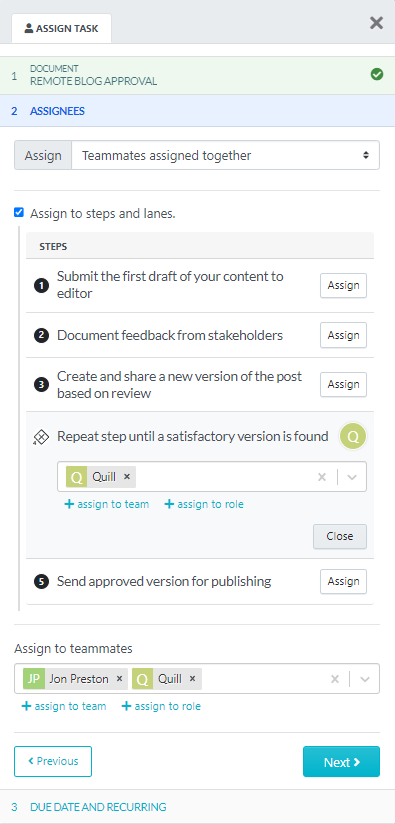
You can manage all your assignments and see their progress from the “Tasks” tab on the top menu. The Tasks menu shows all your current and pending tasks, as well as those you have assigned to other members of your team.
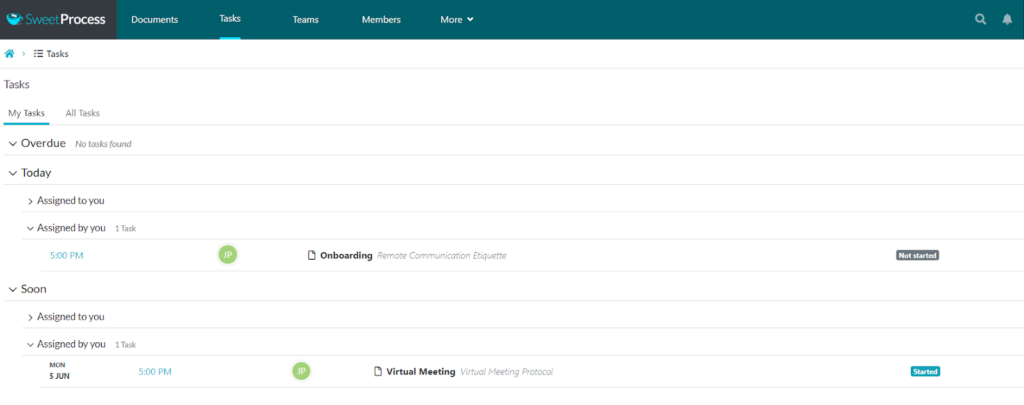
Tasks can be set as one-time, repeated daily, weekly, monthly, or yearly. SweetProcess sends out email notifications to document owners and assignees when changes are made to them.
How to Export a Process on SweetProcess
All documents can be downloaded in PDF, Doc, or HTML formats. To export a process document, navigate to it through the “Documents” tab. Then click on the “Actions” button on the top right-hand side of the screen. Select “Export” and then click on the format you wish to download the document in. You can also download the document with the process map and the approver’s name if you wish.

How to Monitor Process Activity on SweetProcess
All assigned jobs and process activity can be managed from the “Tasks” section on the top menu. Managers can set up tasks and assign them to various teams or individuals. To track delegated job activity, click “Assigned to you” under any of the three headers. Super administrators and managers can also see all task activity by clicking on the “All Tasks” tab.

SweetProcess Pricing
Unlike most other process documentation apps, SweetProcess has a simple, one-point pricing structure. You can either pay monthly or annually. Monthly payments start at $99/month for a minimum of 20 users, with every additional seat priced at $5/user/month. Annual payments are $82.50/month for a team of 20 users, and every additional seat is $4.17/user/month. Smaller teams can get custom quotes, depending on their size.

SweetProcess also has a free, full-featured, no-credit-card-required 14-day trial. In addition, we also offer a 30-day money-back guarantee. With the trial thrown in, you have 44 days during which you have free process documentation software to play with as much as you want.
There are few SaaS-based productivity tools that can match SweetProcess in value offered for the money. In fact, most of our clients start to reap the rewards of having a robust process documentation tool in the free trial. When they decide to add it permanently, SweetProcess is already paying for itself.
2. Pellio
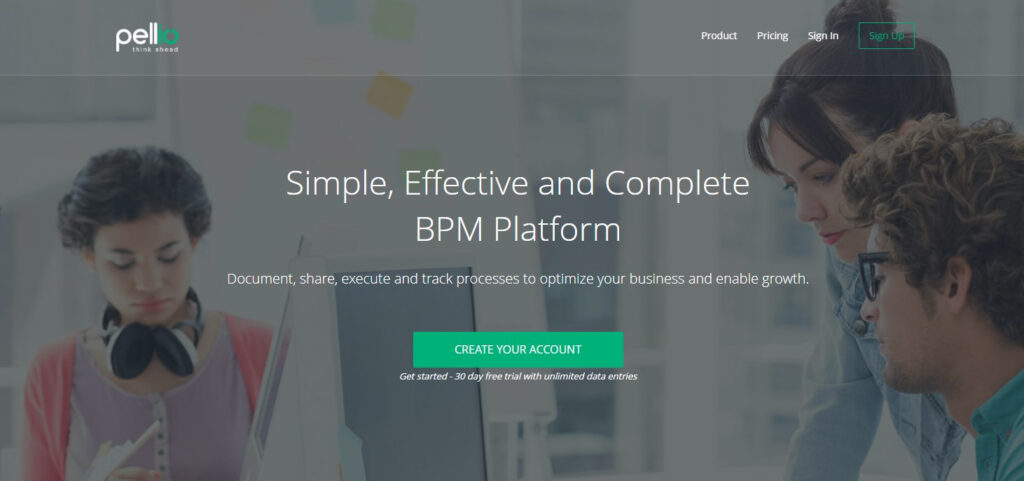
Pellio is one of the newer process documentation systems on our list. It’s also one of the simplest and most straightforward apps out there. Signing up and starting is fairly easy. You have a 30-day free trial, which includes all the features, including unlimited processes and users, user management, and process versioning.
Features
● Simple, no-frills layout.
● Three-step process creation system.
● Excellent task visibility.
● Personalized dashboards for every user.
Pros
Pellio impresses with its “keep it simple” user interface and functionality, which makes onboarding and starting out a breeze. The app barely takes any getting used to, and users can start implementing it almost instantly. Its organizational role allows managers to decide whether a user is a learner, creator, or document owner, which is useful for assigning roles. Pellio’s forms are available in a step-by-step format, which users can use as checklists when working on their tasks.
Cons
The app’s key strength—its simplicity—also acts as a detriment, unfortunately. You are only limited to plain process documents without the three-phase hierarchy available in SweetProcess. While it’s great for companies looking for an easy way to get started with the business process documentation system, those needing more robust documentation features best avoid it.
We also found the app to be a little buggy on certain systems and browsers. Certain documents refused to open or took too long to load.

For example, clicking on the Start button on the introductory processes in Chrome leads to an eternal loading sign without any activity, regardless of how many times we tried clearing the browser cache. The app works fine in Edge, however.
Pricing
Pellio has three pricing tiers: Lite, which starts at $15/month; Startup, priced at $47/month; and Pro, available at $97/month. Unlike most software that charge based on user count, Pellio bases its pricing on the number of data entries. Lite allows for 300 data entries per month, Startup enables 1,500, and Pro lets you make 4,500 data entries every month.
3. Confluence
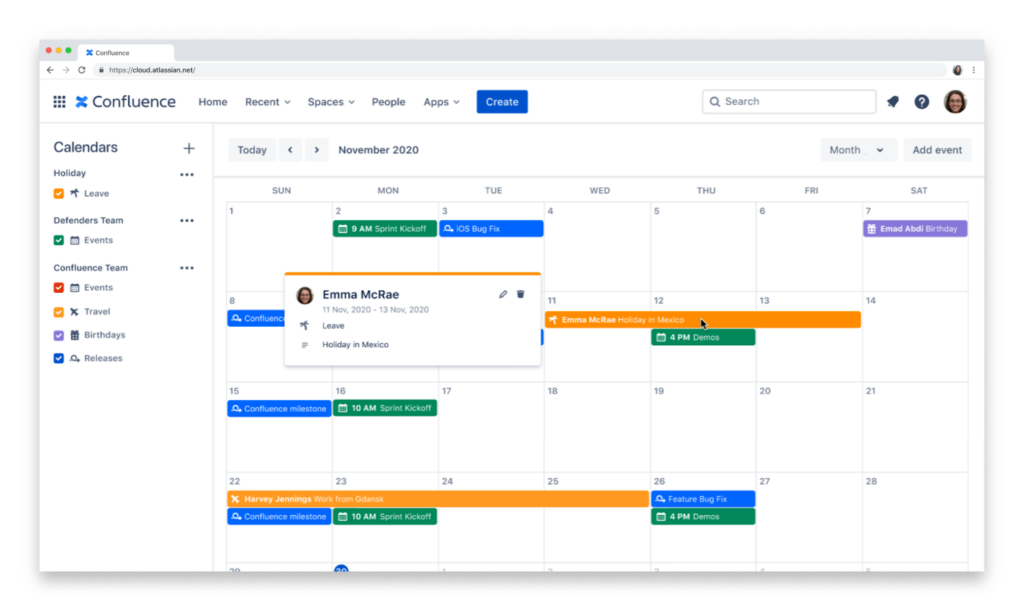
Confluence chooses to separate itself from other apps in its space and calls itself a collaboration space with an emphasis on creating process documentation. It’s not like regular tools for sharing files. In essence, the app is more like a project management solution that helps you work together on things like plans for new products or marketing efforts. You can easily find your work in organized spaces, connect with different teams, and use it with other Atlassian tools.
Features
● Collaborative document creation and editing.
● Dedicated workspaces for organized project management.
● Easy integration with Atlassian Suite.
● Customization options and extensions through the marketplace.
● Version history and tracking for content management.
Pros
Designed by Atlassian, Confluence lives up to its name and is one of the best project management apps out there. Even though the app is quite feature-rich, it manages to have an easy-on-the-eyes user experience that is easy to navigate. Finding and sharing documents in Confluence is simple and straightforward. Being an Atlassian app, it readily integrates with other apps offered by the company. The app also provides a huge selection of templates you can use to create your process documents.
Cons
While the app integrates well with Atlassian’s software, it’s tricky to make it work with other third-party apps. Some users also reported its user management is hard to navigate, which is something we agree with—Confluence’s permission system can certainly use fewer steps.
Pricing
Confluence has a free plan for up to 10 users. Paid plans begin with the Standard version at $57.50 per month, and the Premium version at $110 per month. The pricing for the Enterprise version is available upon request. You can add as many as 50,000 users to all the paid plans. While the free plan may suffice for basic documentation, the Premium version is better if you want a tool that can help you with both recording and implementing different processes.
4. Gluu
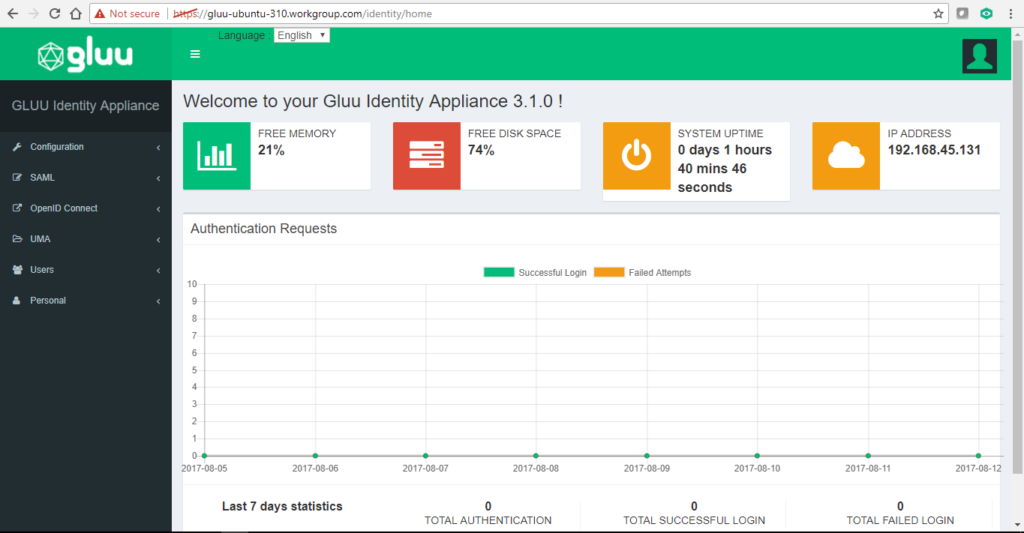
Gluu was founded by Søren Pommer, who during his tenure as a manager for medium and large enterprises, saw how difficult it was to implement processes. In his own words, business processes and agencies mixed like “oil and water” because of difficulties in establishing roles, KPIs, and systems. He discovered that employees, who often didn’t agree with or understand a process, would just check the boxes in their ERP systems to make their bosses happy. The larger a company gets, the more complex its processes get, and consequently, the harder they are to implement.
Pommer founded Gluu to help such enterprises streamline their business processes with an emphasis on implementation. Gluu has several features that make it easy to document processes and create forms, work instructions, and communications to help implement them.
Gluu’s user interface offers a simple process map that showcases a process’s workflow along with the organizational structure. Processes can be assigned tasks through Gluu’s inbuilt forms, and managers can track each task, or an entire project, through a dashboard.
Features
● Role-based access to processes reduces strain on business systems.
● Managers can delegate process creation and management, cutting coordination time by up to 90%.
● Automate recurring tasks to improve data quality through Microsoft Graph integration.
● Powerful compliance features with IT Security, QHSE, and GDPR.
Pros
Gluu lets you map processes and tasks, assign them to the right people, and then track everything through its built-in reporting. The app makes it easy to show when things are being done correctly to customers, authorities, and auditors, and when it is not. As one of the users commented, the app makes it easy to see when work is not moving in the right direction.
The process documentation software lets managers delegate recurring tasks easily. Team members can collaboratively construct process flowcharts, leave comments on documents, add and remove workers, and receive updates every time changes are made to the processes.
Furthermore, Gluu has powerful process mapping tools for designating roles to team members and meticulously tracking task progress at every level. The app sends out alerts to process managers in cases of overdue tasks. Additionally, Gluu also integrates with Office 365 and G Suite along with a plethora of other apps through Zapier, enhancing its versatility and compatibility.
Cons
Despite its strengths, there are a few areas where Gluu falls short. Firstly, it lacks process mining, which means that users won’t be able to analyze actual process data to uncover optimization opportunities. Any optimization will have to be done manually.
Additionally, Gluu seems to be designed specifically for internal processes only, limiting its utility for managing interactions with external stakeholders. These limitations could potentially hinder organizations seeking to collaborate with third parties on projects.
There are a number of Gluu alternatives you can also look into.
Pricing
Gluu starts at $12 per user per month with their Basic plan, at $25 per user per month for their Pro plan, and offers custom pricing for power users through their Enterprise plan. The Basic plan has its core process mapping feature, which can help you get started. However, tools needed to implement your processes (such as forms and analytical reports) are only available in Pro and Enterprise plans. You also have a free 14-day trial, which comes with all the features unlocked.
5. ScribeHow

ScribeHow is a newly launched application designed to record real-time information and create process documents automatically. The process documentation software allows users to effortlessly generate detailed step-by-step guides complete with text inserts and visualizations by capturing their procedures as they are working through their web extension.
ScribeHow is targeted at individuals and companies who are new to business process documentation and want something to help them get a better sense of their work process. Too often, we are so caught up in our work that we don’t realize that the process on paper looks nothing like what we’re actually doing. ScribeHow helps bridge this disconnect.
Scribe’s Google Chrome extension is similar to the SweetProcess Chrome extension. A detailed comparison of their features can be found in this in-depth guide on Scribe Chrome extension Vs SweetProcess Chrome extension.
Features of ScribeHow
● Captures processes as they are being executed.
● Produces detailed visual guides.
● Powerful AI writer automatically creates how-to guides and instructions.
● Out-of-the-box integration with most major project management apps out there.
Pros
ScribeHow offers a user-friendly solution to craft comprehensive how-to guides and tutorials for people of all skill levels. It leverages screen recordings and AI writing to automate documentation and process data generation. Its point-and-click interface enables users of all technical levels to effortlessly create guides and step-by-step instructions without any programming background.
ScribeHow can capture all your web activity, including clicks and keyboard inputs, and produces screenshots and text-based documents through its web extension or its desktop app. With the desktop app, you can record processes beyond your online browser activity. So, if your workflow requires both online and offline activities in a particular sequence, ScribeHow can understand it and build processes accordingly.
Cons
While very useful for real-time information recording, ScribeHow has several limitations as well. Firstly, the free version is limited to recording processes within the browser and not offline work. The free version also lacks organization features like creating branches and subfolders for better categorization.
Additionally, you cannot inject videos and GIFs, which is pretty common in process documentation apps these days. ScribeHow also suffers from bugs that miss capturing clicks or inputs, which gets annoying after a while.
If you find the app unsuited to your requirements, you can also look into a number of Scribe alternatives.
Pricing
The basic version of ScribeHow is available for free, with which you get the web extension and the ability to share documents with your team. Their Pro version starts at $12 per person per month for five users, and $23 per person per month if only one seat is purchased.
6. ProcessMaker
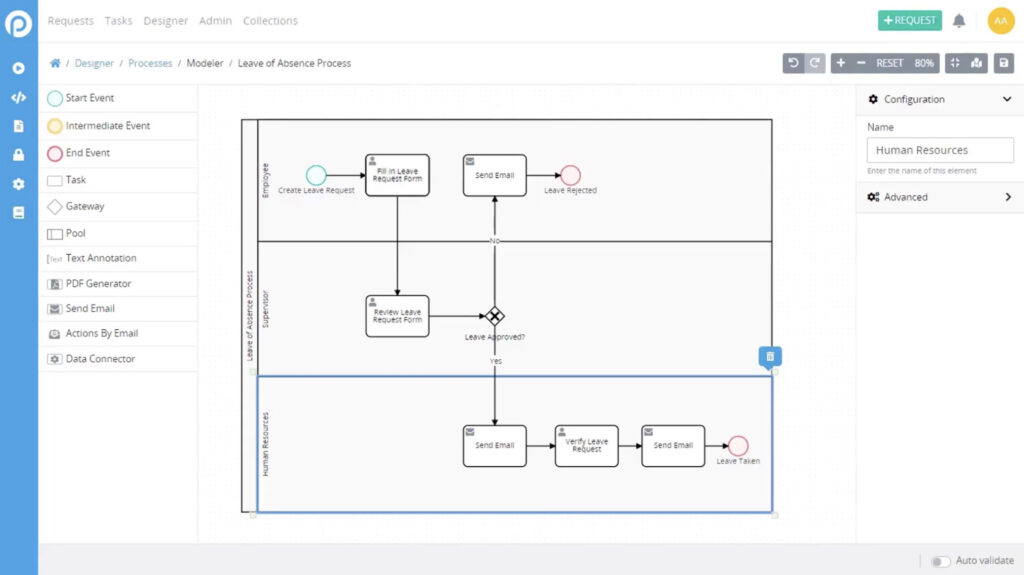
ProcessMaker is a popular BPM tool with a lot going on under the hood. It uses Business Process Management Notations 2.0 (BPMN 2.0), which offers a standardized system for creating workflows with specific rules and iconography that are recognized in many industries. ProcessMaker uses rule-based automation, dynamic forms, and one-click integrations with a number of popular apps to help you make complex processes simpler.
The app has become popular for its low-code workflow automation platform that empowers business users to rapidly design and deploy customized solutions to complex workflow problems. The process documentation tool is ideal for small startups and enterprises alike and is used by companies in healthcare, education, and finance.
Features
● Low-code process-making interface can be used to create process documentation templates for repetitive tasks.
● AI-powered intelligent document processing technology that automates large data processing.
● Specific solutions for companies in healthcare, insurance, banking, education, government, manufacturing, and telecom.
● Formstack WYSIWYG interface can be used to create forms visually.
● Prebuilt connectors can be used to integrate ProcessMaker with popular cloud-based services and apps.
Pros
ProcessMaker positions itself as an enterprise-grade BPM solution, and it excels in that role. The drag-and-drop editor, no-code builder, and AI assistance make otherwise complex process creation methods fairly easy. The app’s process interface is similar to Gluu in that it consists of a process flowchart with an organizational structure using the BPMN 2.0 schema.
ProcessMaker also has other advantages to its credit. Its DynaForm designer can be used to create JavaScript and HTML5-compliant multilingual forms, meaning you don’t have to code or even preview them on various devices. The dashboard can be tailored to provide personalized insights into two KPIs, including process efficiency index (PEI) and employee efficiency index (EEI), with visual data representations.
The process documentation software also has an output document builder for creating printable documents, role-based access, and an email cases inbox for resolving queries. Beyond the web portal, ProcessMaker is available as a mobile app for both Android and iOS, which has all the features available in the web version including automated notifications, customizable dashboards, and performance analysis.
Cons
ProcessMaker has made substantial improvements over time. Even so, there are several limitations to the app. For example, non-technical users may find ProcessMaker’s user interface challenging to navigate since not everyone is familiar with low-code environments. Its mobile app’s functionality also relies heavily on the server being internet-facing, which can limit its utility in certain scenarios.
Furthermore, documentation pages sometimes don’t keep pace with the latest updates, which leads to disparities in versioning. New updates also cause temporary downtimes and introduce new bugs into the system, which can disrupt workflows.
Despite its user-friendly design, ProcessMaker’s documentation can often lag behind its more recent releases. You are left with features, buttons, and columns that weren’t there before, and you have no choice but to figure them out on your own. Finally, small and medium enterprise users may find it hard to justify paying for ProcessMaker’s asking price, which is quite a step up from the other entries on our list. These aren’t a problem in many other ProcessMaker options out there.
Pricing
ProcessMaker starts at $1,475 a month, which includes its basic features such as the process modeler, screen builder, dashboards, task management, and user groups and permissions. This is obviously quite an asking price; the capabilities it includes here are easily available at a lesser cost elsewhere.
Other features like the AI assistant and process translator, decision engine, photo/video capture, document management, AI search, and user activity logging are only available in their Pro and Enterprise plans, which are quoted on request.
7. Flokzu

Flokzu is a remarkably simple BPM software solution that manages to strike a balance between user-friendliness and functionality. Unlike the last entry in our list, it doesn’t require any coding experience to generate process documentation, as it uses an intuitive drag-and-drop interface.
Flokzu’s standout feature undoubtedly lies in its ability to integrate a disparate set of databases. The seamless ability to insert, search, and update records encourages an organized workflow through API’s streamlined data manipulation. The process documentation software also has one of the most intuitive interfaces in the market and barely requires any training to get people started.
Features
● Dynamic spreadsheets for centralized data storage and automated record handling.
● Form fields can be customized based on tasks, values, or decisions.
● Integrate your Flokzu account with thousands of different apps and web services via Zapier.
● Automate your email alerts for internal and external users through all workflow stages.
● Sandbox feature provides a secure testing and process experimentation environment.
Pros
Flokzu certainly comes as a blend of promising features, although the experience might leave something to be desired. Its custom report feature provides an efficient way to tailor reports through filters and data columns, making data sharing easy. The automated email delivery option allows you to automatically convey all updates to your coworkers as to and when they are made.
Flokzu offers a centralized hub for shared data and parameters. The ability to insert, search, and update records through APIs brings a new level of efficiency to data management. However, while the dynamic visibility feature was impressive, it left us wanting more. While modifying form fields based on how a task is progressing is awesome, the execution seemed a bit stuttery at times, and it took a while to get the hang of it.
Flokzu integrates with other productivity apps through Zapier. The ease with which form fields and workflow steps aligned with external systems showed great potential. In conclusion, Flokzu is a software with definite promise, especially with its custom reports and database integration.
Cons
While Flokzu is a great starter business process documentation app, it misses out on some important stuff. For example, you have a fixed dashboard with very few customizable options to work with. While features like dynamic visibility certainly hold potential, they are limited in how users can customize them to their own needs and can benefit from more user-friendly changes.
Flokzu’s external integrations are certainly a point to its credit, but we’d wager there’s plenty of room for improvement. The app doesn’t offer any kind of AI assistance, which is quickly becoming an industry standard. We contend that Flokzu is a tool that has a lot of growth potential and will do well with consistent updates.
Pricing
Flokzu’s pricing starts at $17 per user per month if billed yearly with their Standard plan, in which you get 1,000 process instances, unlimited databases, and ten custom reports. Their Premium plan is available at $22 per user per month and makes everything in the Standard plan unlimited. Flokzu also has Custom and On-Premise plans, which are available on quotation only and are based on the required specifications.
8. Heflo

Heflo was established in 2002 as an information systems outsourcing company. The brand has undergone a remarkable transformation throughout its history. Heflo’s journey began with a focus on controls and process management, which eventually culminated in the launch of its first BPM software, Supravizio, in 2007. Today, it stands as a global leader in business process management (BPM) software solutions.
Since starting out, it has rapidly evolved into a powerhouse with over 300,000 accounts worldwide. Heflo’s ability to provide innovative BPM solutions to companies of all sizes is what sets it apart as a leader in the industry today.
Pros
Heflo is one of the oldest process documentation tools out there and remains a cutting-edge business process management (BPM) software today. Heflo’s standout feature is its intuitive process modeling capabilities. Users can effortlessly design intricate workflows with a user-friendly drag-and-drop interface. For instance, a manufacturing company can map out its production process with ease, visualizing every process step from raw materials to finished products.
Heflo also has some great collaboration capabilities. Its robust task management and real-time notifications keep teams synchronized and accountable. For example, if a marketing team is coordinating a product launch, Heflo can ensure all stakeholders have the process documents they need to perform their tasks and are in contact with their teams throughout the launch.
Additionally, it offers extensive reporting and analytics, empowering organizations to continuously optimize their operations. Heflo is the BPM solution of choice for efficiency and teamwork.
Cons
Heflo, while boasting a user-friendly interface, falls short in advanced process management. Its simplicity comes at a cost, as it lacks the robustness needed for intricate workflow control and business process automation. Organizations seeking more in-depth process orchestration, complex decision-making logic, or advanced integrations may find Heflo’s limitations frustrating.
Additionally, its prioritization of user-friendliness means Heflo’s collaborative capabilities may not meet the demands of teams requiring seamless communication, document sharing, or real-time collaboration. The solution is ideal for companies starting out, but is less suitable for enterprises with complex, multifaceted processes and stringent collaboration requirements.
Pricing
Heflo offers a flexible pricing structure. Its starter plan costs $10 per month per user. Users can choose between a free option or a subscription model, making it accessible for both cost-conscious individuals and businesses looking for its full feature set. Plus, Heflo also offers a free trial to help users explore its capabilities before committing to a plan.
9. Nuclino
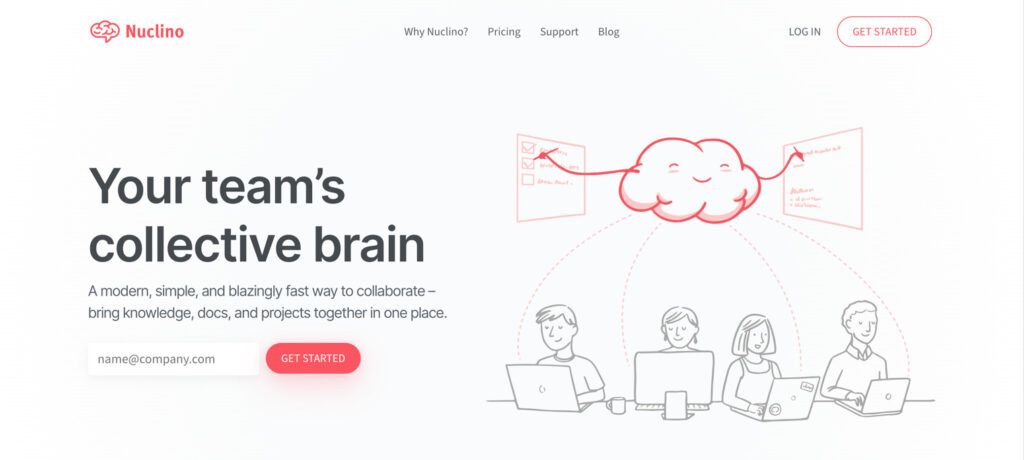
Established by co-founders Björn Michelsen and Jonathan Kienzle, Nuclino is at the forefront of transforming the landscape of collaborative work. Driven by a desire to address the limitations inherent in legacy collaboration solutions, Nuclino’s mission centers on streamlining, expediting, and harmonizing knowledge work processes.
Nuclino’s integrated suite of tools offers teams a seamless and intuitive platform, characterized by its speed and efficiency. With a steadfast commitment to independence, Nuclino has experienced significant growth over a span of six years, and is one of the leading knowledge management applications today.
Pros
Nuclino excels in two key areas: seamless collaboration and structured documentation. Its real-time collaboration capabilities enable teams to work together effortlessly. Users can simultaneously edit documents, brainstorm ideas, and track changes in a shared workspace, fostering efficient teamwork.
Nuclino’s documentation structure is easy to understand and comes with an intuitive knowledge base. Users can create interconnected documents, wikis, and databases, making it a breeze to organize and access vital information. Nuclino’s documentation tools can be used to create comprehensive knowledge bases, FAQs, and troubleshooting guides very fast.
Cons
Though Nuclino has a great, streamlined documentation system, it falls short in crucial aspects of process documentation software. Firstly, it lacks advanced workflow automation capabilities, hindering users’ ability to fully optimize complex processes. This deficiency limits its utility for organizations requiring intricate process management.
Nuclino offers limited integration options, limiting seamless connectivity with other tools and systems essential for holistic process management. In essence, while Nuclino shines in content creation and collaboration, its inability to offer robust process automation and integration solutions leaves a gap for users seeking comprehensive process documentation and management capabilities.
Pricing
Nuclino has a free plan that offers up to 50 items and 2GB of storage. The Standard plan, priced at $5 per user per month, adds unlimited documents, admin tools, version history, SSO, 10GB storage per user, and AI assistance. Larger teams and businesses can go with the Premium plan, which is available at $10 per user per month, and offers audit logs, team insights, advanced security controls, 20GB storage per user, and AI support.
- Nuclino is a knowledge management tool. It is a good alternative to similar tools like Tettra and SweetProcess
8 Top Features to Look Out for in Process Documentation Software

Process documentation software serves a particular purpose in an organization; as such, some specific features may not be found in standard SaaS productivity tools. Here’s a list of features that we consider vital in a process documentation tool.
Intuitive and Easy Import/Export of Documents
Chances are your organization already has a lot of process documentation it’s using on a daily basis. A good process documentation software should allow you to upload and manage existing data with as little effort as possible. It should also be able to recognize and work with different file types.
Equally important is the ability to export files whenever needed. You may want your process documents to be available for offline use, or as backup in case there’s an outage. A good process documentation software should enable you to download your documents in at least PDF, .doc, and markdown formats.
Shareability and Accessibility of Documents
Shareability and accessibility are central to process documentation software as they facilitate seamless collaboration and knowledge sharing among teams. With shareable documents, multiple users can access, edit, and comment on files simultaneously, promoting real-time collaboration. Accessibility ensures that team members can retrieve critical information anytime, anywhere, enhancing productivity and decision-making.
This functionality typically works through cloud-based storage and sharing platforms. Users upload documents to a central repository accessible through web browsers or dedicated applications. Permissions can be set to control who can view, edit, or comment on documents.
Real-time synchronization ensures that changes made by one user are instantly visible to others, fostering efficient teamwork. Shareability and accessibility in process documentation software streamline workflows, promote transparency, and empower organizations to maintain up-to-date and consistent process and user documentation.
Automatic Document Versioning and History
If you’ve ever had to search an email string to find a particular document version, you would know how important automated document history is. While having the most up-to-date version of a document is crucial, you may need different versions of a document for testing or to enable different task requirements.
A good business process documentation software needn’t only record a document’s history, but allow you to create different versions effortlessly. For example, SweetProcess creates different versions of a document every time you make changes to it. So, if five changes were made to a process sheet, five versions will be created.
A Well Thought-Out Knowledge Hierarchy
Simply uploading information to a central repository isn’t enough to make process management work. Your knowledge needs to be given a proper structure to be useful. Hierarchies are an often overlooked and underutilized feature in process management because many consider it easier to just dump documents under headers and into folders and search for what they are looking for later.
A good hierarchy can help you save a lot of time. For instance, SweetProcess breaks down all data into three categories: policies, which are top-level principles that guide the overall organizational actions; processes, the map that illustrates the way to a goal; and procedures, which are step-by-step instructions on how to achieve the goal.
Versatile Search Engine
Besides helping you catalog and manage your documents, process documentation software should also ensure you can find relevant information as quickly as possible. Knowledge bases and hierarchies can be useful here. However, the search engine built into the software should be capable of not only finding relevant documents, but information within them. Locating specific pieces of information is crucial since in most cases they are all that’s needed.
Easy Integration With Productivity Tools
Integration with third-party apps is pretty much a given these days with any SaaS productivity tool. It’s crucial for process documentation software for a number of reasons. First, most companies today have their process data spread across multiple platforms. If documentation software cannot talk to them, all data must be manually uploaded, greatly increasing the chances of human error.
Next, since your processes will be applied in real time, all data must seamlessly flow from all endpoints to where it needs to go. Since process documentation software will serve as your organization’s nerve center, it needs to be able to integrate with any productivity app you may be using.
Team Collaboration
Collaboration is indispensable in process documentation software since these tools are designed to facilitate teamwork and knowledge sharing. Some features you should look out for are real-time editing and commenting, assigning tasks, setting deadlines, and tracking progress.
Furthermore, automated updates ensure that all stakeholders are on the same page for all the documents that are assigned to them. These capabilities enhance the quality and accessibility of process documentation, making it an invaluable asset for organizations striving for continuous improvement.
Support for Multiple Devices
At this point, supporting all kinds of devices, whether they be mobile or desktop, is a given in any SaaS tool. With access across devices, teams can edit manuals on laptops, reference procedures on tablets, and even make quick updates via smartphones, ensuring uninterrupted workflow.
For instance, an engineer on-site can instantly update a maintenance manual from a mobile device, while a manager reviews it on their desktop. Multi-device compatibility transforms process documentation into a dynamic, collaborative resource that enhances teamwork and productivity across all work scenarios.
How to Choose the Best Process Documentation Tool for Your Company’s Needs

Many companies opt for SaaS-based tools in the hopes that they will lead to productivity gains with varying degrees of success. However, for a process documentation system to be really effective, it needs to fill a niche requirement within your organization. There are also several steps that must be taken in order to get the most out of such an investment.
Conduct a Needs Assessment
A needs assessment is a systematic process to identify and analyze gaps between the current and desired states. Every organization has competing needs within it, especially as it grows. Teams clamor for resources, and it can be hard to prioritize requirements such that the company as a whole benefits. A needs assessment can help you make sense of things by ascertaining which processes require your attention now, and which can wait.
For example, Chip Hardt, COO at dscout Inc., a consumer insights company, discovered several bottlenecks in their business processes. Many of their processes were manual, and there was a constant battle for resources within the company between different teams, hindering the smooth flow of tasks and information across the organization.
Chip decided to use SweetProcess to optimize its operational efficiency. SweetProcess allowed better transparency in dscout’s business processes. As people were able to collaborate on their processes, all team members could have their voices heard, giving everyone a good idea of the entire picture.
Chances are, your company has such issues that are causing friction and slowing everything down. Such inefficiencies are a great place to start your process optimization journey. Once you’ve learned to improve your worst-performing processes, the chosen solution can be gradually rolled out to other functional areas, if needed.
Understand Which User Interface and Workflow Design Capabilities You Need
There are a plethora of organizational philosophies, tools, and methods ranging from Kanban boards, scrum boards, task lists, and chat boxes, to simple document-based formats and flowcharts. Not all will fit your working style or current requirements.
You can start by assessing how complex the processes you’re trying to create a system for are. For example, simple processes might involve employees within a single team, leaving requests. More complex processes like a software development project could span entire teams and stages.
For example, a startup in the SaaS space with simple processes would look for a process documentation tool that is affordable, scalable, and flexible. The priority here would be a user-friendly interface that a small team can quickly learn, and customizable workflows to accommodate evolving needs. Visual task management, integrations with third-party apps, and the ability to grow with the company will be important here.
Keep Your Focus on the Total Cost of Ownership (TCO)
When selecting any SaaS vendor, it’s easy to take the upfront yearly cost, multiply it by the number of years used, and come up with a figure for how much you can expect to pay in the long term. Unfortunately, SaaS tools are notorious for hiding their real TCO. Many studies claim poorly considered cloud-based apps often end up costing just as much, if not more than, on-premise solutions.
Let’s say you’re planning to invest in process documentation software, which costs $80 per month for a team of ten people. The direct subscription costs will be $960 per year. However, we also need to consider the indirect costs here. These can include user expansion, training and onboarding, custom integrations, and data migration.
User expansion is a given as the company grows; however, the pace at which a company may add new employees is hard to predict. Training and onboarding can be equally tricky since the costs here have more to do with diverted time and resources away from productive activities. The cost of data migration varies from company to company and app to app. Here’s an example TCO calculation for three years:
Annual subscription at $80 per month (@ 10 users) = $960 per year
Year 1: $960 + $500 (training ) + $300 (migration) = $1,760
Year 2: $960 + 2 new users (at $8/user) + $500 + $600 (integration) = $2,252
Year 3: $1,152 (@ 12 users) + 6 new users + $500 = $2,228
The above calculation illustrates the fluid nature of SaaS pricing, which is only exacerbated by the different models that vendors often use. For example, Pellio uses the number of data entries rather than user count, while Confluence uses a flat pricing scheme. While discussing pricing with your chosen vendor(s) is recommended, you’ll get a much better idea through a small trial run on a budget you can afford.
Find a Solution for Your Business’s Current Challenges
SaaS tools, when implemented correctly, often have a compounding effect on both productivity and earnings. In this sense, they go much beyond the simple savings you can expect by lowering your TCO and removing on-premise infrastructure. However, the tool needs to be matched to the challenges that your business is currently facing.
For example, Tom Vranas, VP of innovation and culture at Everywhere Wireless, faced a unique challenge when the company started growing. The company’s expansion led to an increase in operational demands and knowledge distribution problems. The company was using a combination of manual processes, shared drives, sticky notes, and ad-hoc collaboration models, which were no longer suited to its present needs.
After testing around 70 workflow software options, SweetProcess emerged as the optimal solution as it provided a centralized platform where the support team could quickly access all the information they needed to assist customers. This streamlined customer interactions, reduced response times, and enhanced overall customer satisfaction.
Don’t take our word for it. Try SweetProcess for free with our 14-day trial and see how we’ve helped hundreds of companies achieve process perfection.
What is a Process Documentation Software?

Process documentation software is a tool designed to create, store, and manage process documents and data like SOPs, workflows, and corporate best practices. These apps allow users to visually map out business processes using flowcharts, diagrams, or other graphical representations.
Process documentation apps improve efficiency, quality control, and compliance by providing a structured framework for documenting complex workflows. Users can upload, create, edit, and collaborate on documents, ensuring clarity and consistency in documenting processes across their departments and organizations. Multiple users can contribute, comment, and review documents, improving collaboration and knowledge sharing. This ensures that everyone has access to the latest version of a process, which is especially valuable for remote or distributed teams.
Additionally, process documentation tools also integrate with other productivity software, enabling the seamless incorporation of process documentation into daily operations. Furthermore, they offer version control and audit trails to track changes and maintain a history of process revisions, which is essential for compliance and accountability.
Why Should Your Company Use a Process Documentation Tool?

Owning a business essentially means owning a process. How your company delivers value to its customers is both its unique selling point and its trade secret. But your business processes are also not static. They evolve with market conditions and time, which is why you need to have a strong process documentation system.
While most companies have standard operating procedures and work instructions, they rarely suffice in the hyper-velocity business environment of today. Many companies don’t give process documentation the attention it deserves.
In fact, an Adobe report showed that 97% of organizations covered had minimal process documentation systems in place, and 72% used a mix of digital and paper-based process management methods. Several key trends are accelerating the adoption of digital process documentation apps today.
Firstly, antiquated document versioning and storage methods are real and established threats to productivity. Employees in any company without cloud-based process management apps spend far too much time trying to find what they’re looking for either in email threads, company servers, or hard drives.
An IDC study found that workers spent 2.5 hours per day (8.8 hours per week) finding and sorting through information. These conclusions were reflected by another study commissioned by McKinsey, which pegged the amount of wasted time at 1.3 hours per day and 9.3 hours per week.
Secondly, any company that still relies on paper-based process documentation cannot go remote. As such, it might lose to competitors that create remote teams, driving down operating costs while increasing productivity.
Modern cloud-based process documentation apps enable companies to share important information remotely, collaborate across borders, and ensure business continuity in the event of unforeseen events, like the 2020 pandemic.
Finally, the Adobe report also found that better documentation methods directly impact customer satisfaction. The best process documentation tools ensure teams work fast and efficiently, which means customers are served quicker and better. Forty-seven percent of executives covered in the Adobe report stated improving customer experience was one of the primary drivers of adopting digital documentation systems.
Most process documentation software offer the following features out of the box:
● Checklists
● Policies
● Forms
● Tutorials
● Screenshots
● Links to other applications
Here are some of the benefits that process documentation can bring to the table in your company:
Improves Business Processes
More often than not, people tend to rely on their memory or “hunches” to perform tasks, even when they have SOPs in place. The problem with guesswork is that you often have to start from scratch, meaning there is no way to determine what the final outcome will be.
While improvisation and pivoting on a dime are sometimes needed, deviating too much from your company’s methods can result in bad customer experiences and inefficient workflows. Process documentation software ensures that tangents never arise and everyone remains on the same page.
Captures All Those A-ha Moments
Everyone brings a fresh perspective to your organization. You often have people coming up with brilliant ideas that could radically alter your SOPs for the better. Manual process documentation is usually not well-equipped to incorporate such suggestions quickly and efficiently.
The result is that those epiphanies often go unrecorded, and what could’ve been a huge business process improvement is easily lost. Process documentation software helps you avoid such pitfalls. Since everyone’s working with the same system, their inputs are automatically recorded into the process map.
Creates Workflow Efficiencies
Beyond the cost of wasted hours that companies have to pay for, faster process documentation can help ward off other expenses too. Cloud-based apps are far more affordable than the slow, rigid, and expensive IT legacy systems. Process documentation also makes setting up new processes quicker, thereby maximizing time, money, and resources.
Simplifies Documentation
It’s hard to put a price tag on process errors. Sometimes they may only lead to lost time. On other occasions, you may have a customer relations fiasco and million-dollar lawsuits. Process documentation apps can radically reduce error rates by ensuring all your sources of truth are under one roof and easily accessible by anyone needing them.
Creates Standardization and Consistency
Businesses that survive continue to survive and can even thrive. Consistency in operations makes a difference in your organization’s survival and growth.
Differences in styles can cause variations in process outputs when it comes to employees. However, standardized documentation eliminates this problem and allows quality to be achieved and sustained in business.
Improves Employee Onboarding
Gone are the days when a simple employee handbook and a tour was enough to help a new hire acquaint themselves with their new workplace. Since most companies are moving to either fully remote or hybrid workspaces, cloud-based collaboration apps such as process documentation software are no longer optional. These tools are great for onboarding precisely because your new employees can find everything they need in one place, and you can also design specific onboarding training regimens.
Gives You Better Insights Into Your Processes
All process documentation apps come with dashboards and powerful analytics that help you get a better understanding of what is happening in your organization in real time. Analytics are even more important in process management as you often need to pivot quickly to tackle new situations.
Increases Process Compliance
A process documentation tool provides a centralized platform for documenting and managing standard operating procedures (SOPs), which increases compliance throughout the organization. For instance, in a pharmaceutical company, such a tool ensures that all employees follow FDA guidelines precisely when manufacturing medications, reducing errors and promoting adherence to regulatory requirements.
Sign up for our 14-day free trial to see how easy documenting and managing processes is with SweetProcess.
Document and Manage Your Company’s Processes in One Place Using SweetProcess

A recurring theme in all the apps we’ve covered (and the ones we considered) is that they focus solely on one-dimensional process information. Unfortunately, many vendors try to pass policies and procedures as synonyms for processes, which is just flat-out wrong. Here’s how the three are different:

As we stated, an organization needs a good grasp of its policies, processes, and procedures to work efficiently. Consider this: A team member comes up with a procedure that seems effective but goes against the company policy. If a well-defined policy document is missing, how will you decide whether to allow or disallow the procedure?
SweetProcess was built from the ground up to address such issues. The app design ensures that everyone not only knows what they’re supposed to do but acts in a manner in keeping with the company’s spirit within their day-to-day operations. In this sense, all levels of your organization are accountable for its overall goal.
For example, Ginkgo Residential, a real estate company with an emphasis on eco-friendly, affordable housing, saw a knowledge imbalance in its employees. While the company had manuals and guides, they lacked clarity and precision, making them ineffective in informing employees on what actions needed to be taken.
Additionally, pockets of tribal knowledge had formed within the company, leading to some employees outperforming (read: working harder) others. The lack of sufficient know-how meant tasks being performed incorrectly, lack of coordination, and some employees not taking any action, which negatively impacted the overall output. This was a significant pain point as it hindered the company’s efficiency and effectiveness.
Ginkgo Residential successfully resolved its problem by meticulously documenting its policies and procedures with SweetProcess. This documentation served as a clear hierarchy where policies informed their procedures, which consisted of specific, actionable steps.
Moreover, SweetProcess’s unique capability to help employees cross-reference procedures and processes with policies within relevant documents provided context and clarity. SweetProcess’s documentation strategy helped Ginkgo create a streamlined approach that enhanced accountability. Since employees can comment on process documents, Ginkgo sought feedback from employees, which enabled continuous refinement of their policies and procedures.
We have a number of such success stories where SweetProcess’s innovative, yet time-tested approach has helped companies of all sizes of industries streamline their process methodology.
Ready to scale your business? You can start by trying out SweetProcess for free with our 14-day trial.
FAQs About Process Documentation Software

How is process documentation software different from other productivity apps?
There are a lot of SaaS-based applications out there, and all of them have some documentation system. While all apps need some degree of process control to work, process documentation software is specifically designed to manage your company’s overarching goals and strategies. In this sense, a process documentation system works as a nerve center for your company’s various systems, providing data on demand.
We should also point out that your process data may differ from app to app. Companies that use multiple software often see pockets of tribal knowledge develop in departments using specific tools. Process documentation software can combat this problem by centralizing all your know-how under one roof.
How secure are process documentation apps?
Most process documentation software is cloud-based. As such, they are usually backed by very strong security measures and redundancy. We should add that not all applications are created equal, and you should inquire about your selected application’s security measures from the vendor before moving forward. Inquire about the application’s data encryption, backup procedures, and compliance with standards like GDPR, HIPAA, or ISO 9001, depending on your industry.
What analytics and reporting features are available to track process documentation usage and performance?
To track process documentation usage and performance, organizations can leverage analytics and reporting features such as user engagement metrics, document access logs, and version history tracking.
User engagement metrics can provide insights into how frequently documents are accessed, how long users spend on them, and which sections are most popular. Document access logs help monitor who is accessing documents, while version history tracking ensures changes and updates are recorded, aiding in performance evaluation and compliance monitoring.
What is an example of a process document?
A process document outlines the steps and procedures for performing specific tasks or enabling workflows. For example, an employee onboarding document can include instructions on how to welcome new employees, complete paperwork, provide basic training, and set up access to company systems. It can also include timelines and responsible parties to ensure a smooth and consistent onboarding experience.
What types of processes can these apps document?
A process documentation app can capture and document both simple and complex workflows. These can include operational procedures, project management processes, compliance and regulatory procedures, customer support protocols, and manufacturing workflows. Some apps are specifically designed for certain industries and will have features that can enable workflows to be more optimized for the same.
Ready to take your business to the next level? Get started by exploring SweetProcess with our complimentary 14-day trial.
